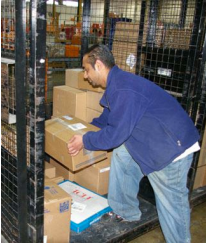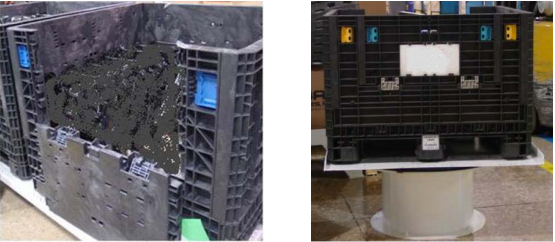Concern details
Background:
When packages exit the cubing machine, they are sorted into cages and carts for transport or to be pushed to different areas around the facility to be sorted further. Workers are required to load and unload packages from the carts and cages.
Evaluation:
This job results in poor lifting conditions which are causes for concern as the location of the packages are outside the preferred lifting zone of 75 cm to 110 cm vertical height and horizontal reach of 40 cm (5th percentile female reach distance with elbow at side of body) [1].

Horizontal reach:
When loading and unloading the cages, workers are required to retrieve and place items to the back of the cage which results in extended horizontal reaches up to 126 cm. The entire population is physically not capable of reaching the back of the cage [1]. The maximum forward reach distance should not exceed 70 cm [2]. However, this task results in repetitive reaching into the cages, therefore the recommended maximum forward reach for repetitive tasks is 50 cm [2].
Vertical reach:
The vertical reach required to load and unload the top of the cages (199 cm) cannot be accomplished by any of the population, and exceeds the overhead functional reach of 188cm [2]. It is recommended to modify the cages so the maximum vertical reach does not exceed shoulder height of 121 cm [1].
In addition loading the packages to the bottom of the cages 15 cm is cause for concern due to extreme back flexion. To reduce back flexion when lifting, the minimum vertical height should be above 95th male knee height of 50 cm [2]. Note that this assessment is of the design of the carts and cages and not a full lift assessment.
Summary:
Overall, the horizontal and vertical reaches required when loading and unloading packages into the cages and carts result in awkward back, shoulder and elbow postures which are cause for concern. The packaging handling results in increased risk of injury due to the heavy, repetitive, awkward postures required to lift and lower the packages.
Countermeasures
Countermeasures are recommended to reduce the risk of injury to the workforce when loading and unloading packages into carts and cages.
The optimal countermeasure would be to redesign the carts and cages so the minimum vertical lifting height is 45 cm, maximum vertical height is 140 cm and maximum horizontal forward reach distance is 50 cm [1, 2]. This can be achieved by designing crates without wheels that are no more than 95 cm high and 45 cm deep and then stacking the crate on a raised table so the bottom is at 45 cm from the ground. The depth of the crate can be increased if the crates can be opened from both sides and then the crate must then be stacked on a lift and rotate table. The crates would be moved with forklifts and would be stacked in the trailer to optimise truck capacity.

Additional countermeasures include:
- Remove wheels from cages so workers can enter the cage safely to reduce horizontal reach with loading and unloading packages. The cages would have to be moved with forklifts or hand truck.
- Optimize conveyor system and sorting system to reduce the number of wheeled cages and carts and to reduce the amount of multiple handling of packages.
- Redesign carts and cages with a divider in center of cage and openings from both sides of cage to decrease forward reach.
References
- Pheasant, S. And Haslegrave, C. (2006). Bodyspace: Anthropometry, ergonomics, and the design of work, Taylor and Francis Group.
- Eastman Kodak Company. (2004) Kodak’s Ergonomic Design for People at Work (2nd Edition) (S. N. Chengalur, S. H. Rodgers, and T. E. Bernard, Eds.) John Wiley and Sons, Inc., New Jersey.